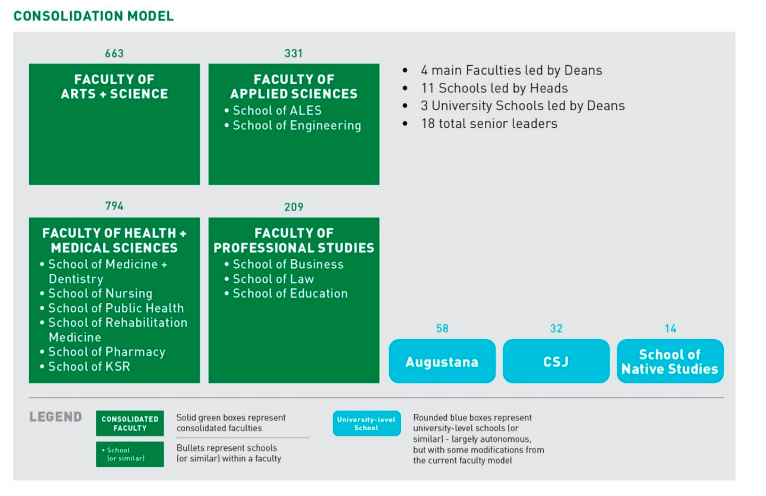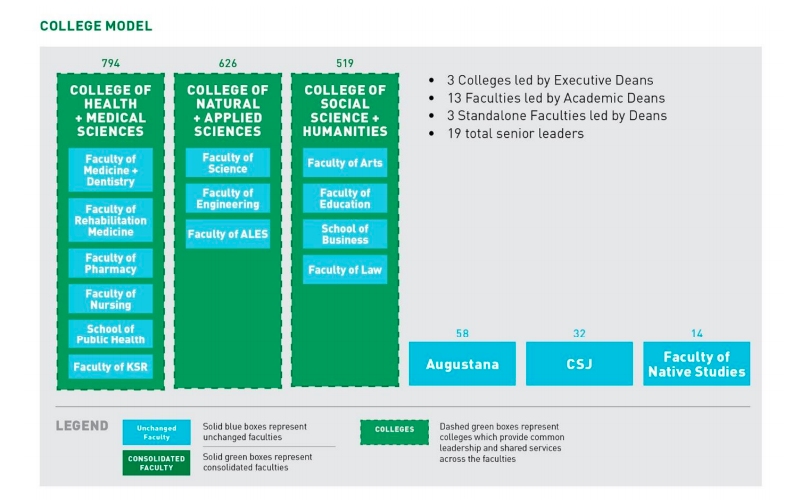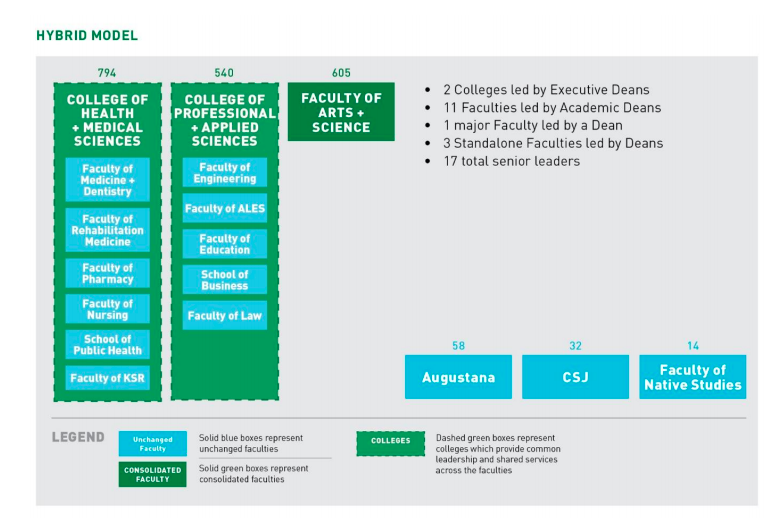Revised academic restructuring proposals: a summary of new changes to each proposal
The revisions come after seeing a division between community members worried about retaining faculty identity and those who worry about extra layers of leadership positions
 Nana A
Nana AThis article is part of The Gateway’s ongoing coverage on academic restructuring. Click here to read about the first academic restructuring proposals and the latest town hall.
Almost two months after its initial debut, the University of Alberta has released revised academic restructuring proposals.
The first academic restructuring proposal saw three different scenarios: scenario A which created a consolidated health sciences faculty, scenario B which sorted most faculties into three administrative divisions, and scenario C which was a hybrid of the previous two, combining facilities like arts and sciences while organizing faculties such as education and law into one administrative division.
The Academic Restructuring Working Group (ARWG) released a document of revised academic restructuring proposals, renaming each scenario to the consolidation, college, and hybrid model respectively. Alongside changing their structures, the report also updated the estimated cost-savings associated with each model. The faculties of native studies, Campus Saint-Jean (CSJ), and Augustana now remain autonomous in every model.
General Faculties Council (GFC), which is the highest academic governing body at the university, first discussed the revised proposals at its November 23 meeting and will vote on which proposal they prefer on December 7. This proposal will then be presented to the Board of Governors, the university’s highest overall governing body to be voted for approval on December 11.
Revised academic restructuring proposals based on polarized community feedback
At a November 16 Academic Planning Committee meeting, which is a subcommittee of GFC, provost and vice-president (academic) Steven Dew said the revisions were guided by a division in community feedback.
“[Colleges] are preferred by those for whom the ability to continue to have their faulty identity is critical. [We are] particularly hearing this on the professional faculty side that [having a distinct faculty] is really critical to that program’s identity, to its accreditation, it’s stature in its professional community.”
“On the flip side, we have also heard concerns about the idea of an executive dean and introducing another level of the hierarchy. For those folks what tends to be preferred is a consolidation approach — let’s not create another layer in the hierarchy, but rather just conglomerate our faculties into bigger units.”
Dew said those worried about faculty identity tend to come from the professional faculties while concerns about extra layers of bureaucracy are heard from foundational faculties like arts and science.
Dew conceptualized the revised academic restructuring models as reflecting this polarization in community feedback, with the consolidation and college models appeasing to one side of the division and the hybrid model striving for middle ground.
Consolidation model now goes beyond health sciences
Previously known as scenario A, the revised model now features multiple consolidated faculties, rather than a singular consolidated health sciences faculty.
The consolidation model now features a consolidated faculty of applied sciences containing the school of agriculture, life, and environmental sciences (ALES) and school of engineering; a faculty of professional studies containing the schools of business, law, and education; a faculty of health and medical sciences containing the schools of medicine and dentistry, nursing, rehabilitation medicine, public health, pharmacy, and kinesiology, sports, and recreation (KSR); and a combined faculty of arts and science without any schools.

As Dew explained, heads of schools will lead the academic programming, such as the programs offered. Unlike faculties, schools will not retain administrative responsibility.
According to Dew, the consolidation of arts and sciences without any schools reflects concerns about extra bureaucracy.
“This was the part of our institution that was most concerned about having a layer [of extra leadership],” he said.
Consolidating beyond health sciences will increase the projected cost-savings of this model from $10.6 million to between $25.9 and $35.2 million.
Each faculty will be headed by a dean and each school will fall under the leadership of a “head.” The faculty of native studies, Augustana, and CSJ will remain autonomous “university schools,” each lead by a dean. Ultimately, this model will create 18 “senior leaders.”
In terms of governance, each school and consolidated faculty will create a council which will have seats on GFC for decisions. The university schools of native studies, Augustana, and CSJ will also have their own councils which will also report to GFC.
Divisions changed to colleges to foster a sense of unity
Now known as the college model, few significant changes have been made to what was previously known as scenario B or the tri-agency alignment.
With the exception of Native studies, Augustana, and CSJ, the remaining faculties are still divided into three over-arching administrative groups.
However, instead of being called divisions, these faculty groupings are now being called colleges. Dew explained that the changing in name reflects concerns over the divisiveness.
“We hear quite a few folks express concerns about the word division. It sounds like we’re keeping people apart rather than bringing them together,” he said.
“There’s no perfect word here, but college seemed to be something that resonated a little more strongly with the working group.”

Other than the shift to colleges, the division of faculties remains the same as previously proposed and administrative services will still be provided at the college level.
The college of health and medical sciences will contain the faculties of medicine and dentistry, nursing, rehabilitation medicine, pharmacy, KSR, and the school of public health. The college of natural and applied sciences will consist of the faculties of science, engineering, and ALES. The college of social science and humanities will contain the faculties of education, arts, law, and business.
The estimated cost-saving associated with this model has been updated, dropping from the previously estimated $43 million in savings to between $30.9 and $40.7 million.
Each division will be lead by an executive dean and each of the 13 faculties will be guided by an academic dean. Considering the three deans that will be in charge of the three stand-alone faculties, this model will have 19 leaders.
In this model, each faculty will keep its already existing council. The only possible change to GFC would be creating seats for the executive deans of each college. Similar to current operations, decisions will flow from faculty councils to GFC. The university does not foresee college-level governance.
Hybrid model still aims to find middle ground in revised academic restructuring proposals
Scenario C, now known as the hybrid model, remains a compromise between the previous two models, but has been updated to reflect their revisions.
This model now consists of a consolidated faculty of arts and science, and the college of health and medical sciences exactly as described previously. This model also introduces the college of professional and applied sciences, which consists of the faculties of engineering, ALES, education, business and law.
This model’s estimated cost-saving has also been decreased from $45 million to between $31.8 and $40.6 million.

With two executive deans leading the colleges, each faculty’s academic deans, and the deans leading the autonomous facilities of CSJ, Augustana, and Native studies, this model results in 17 leader positions.
With the exception of creating a consolidated arts and science council, each faculty will keep their council and will continue to answer to GFC.




